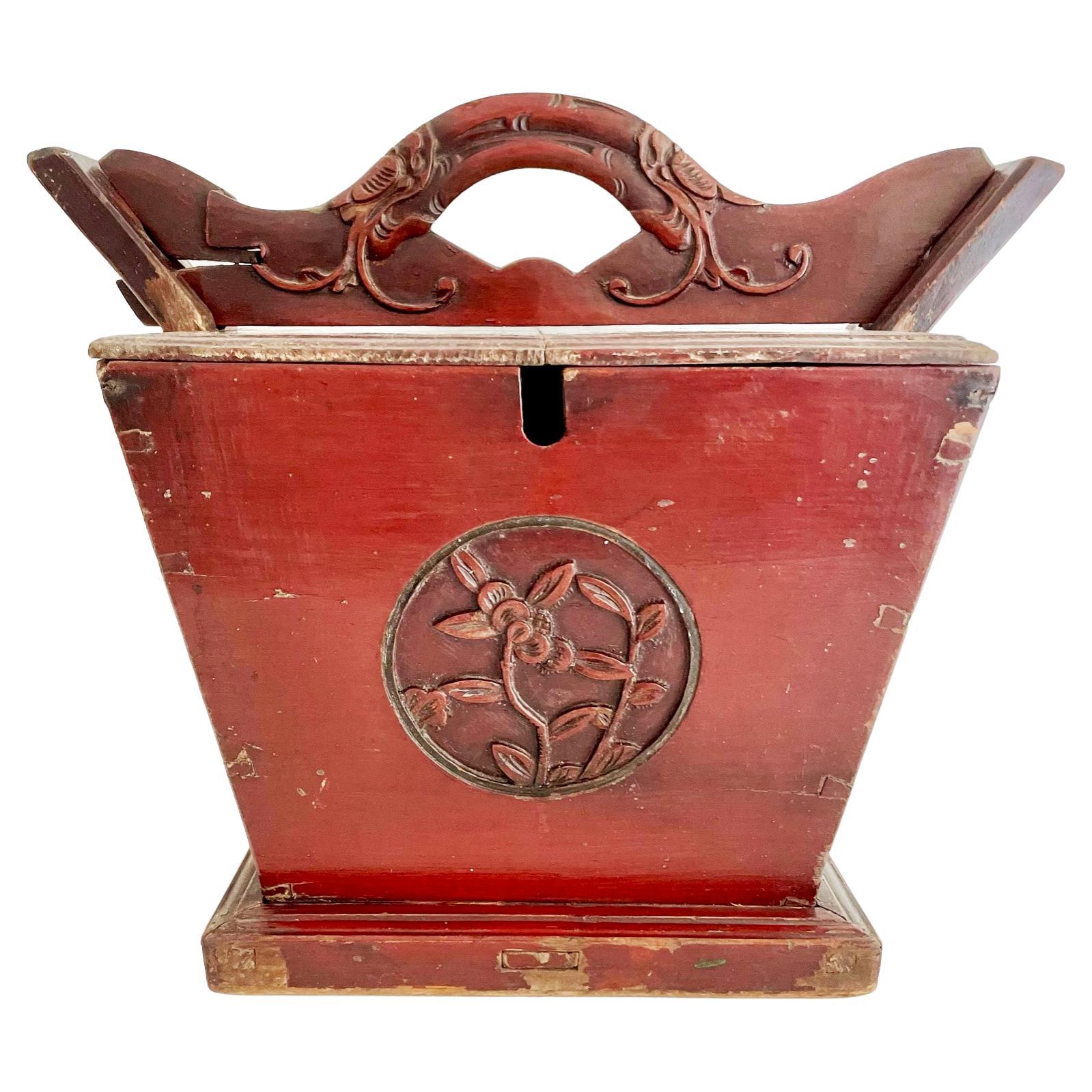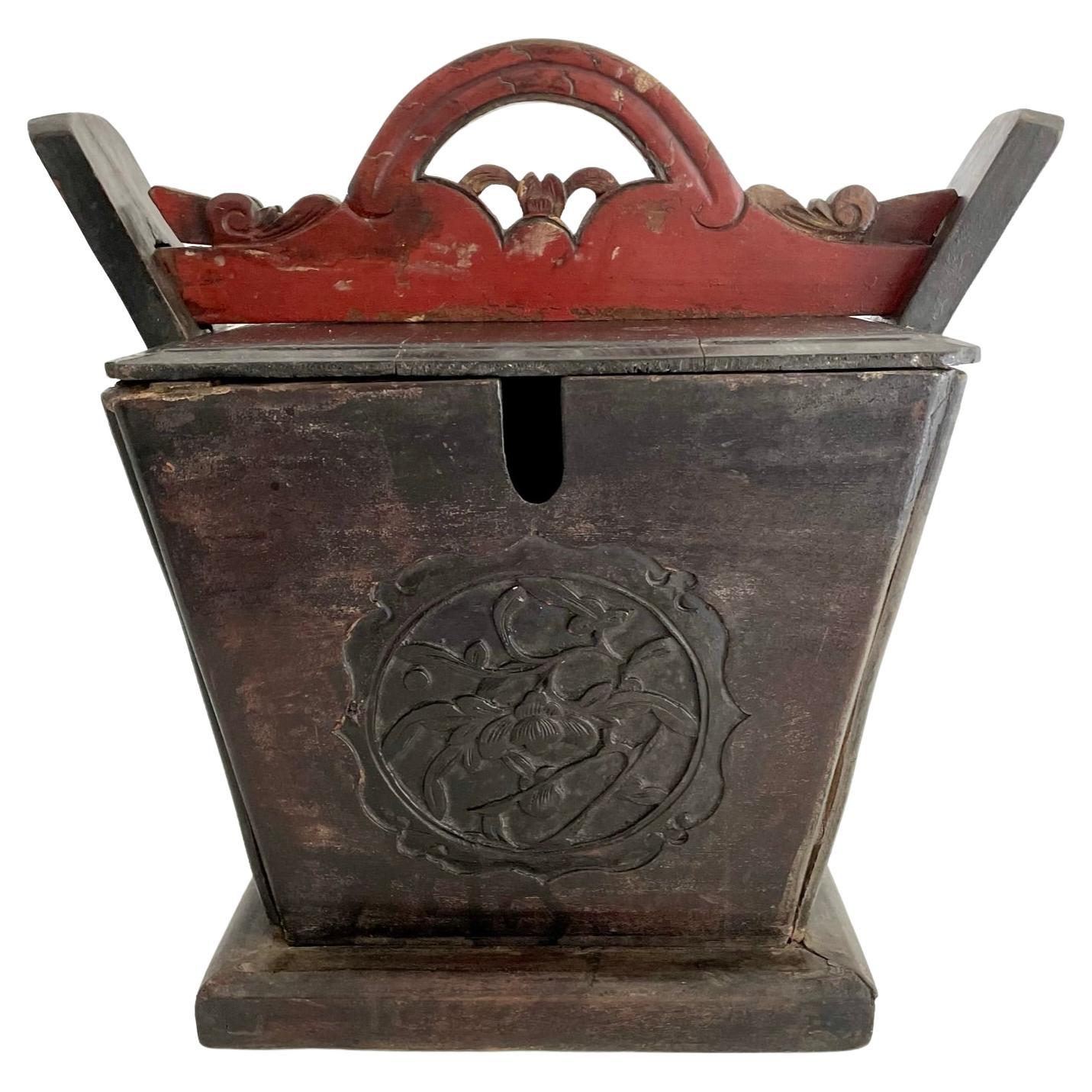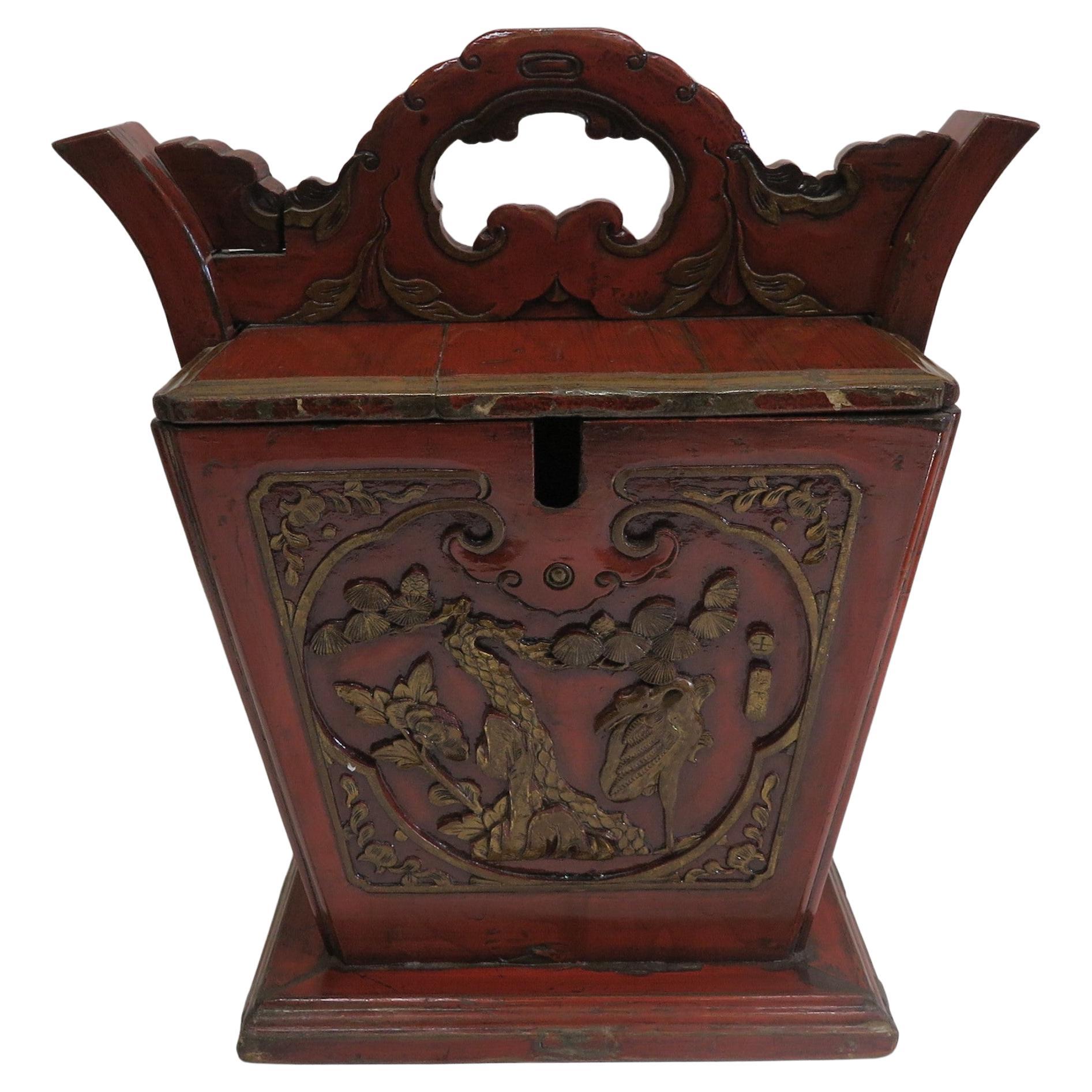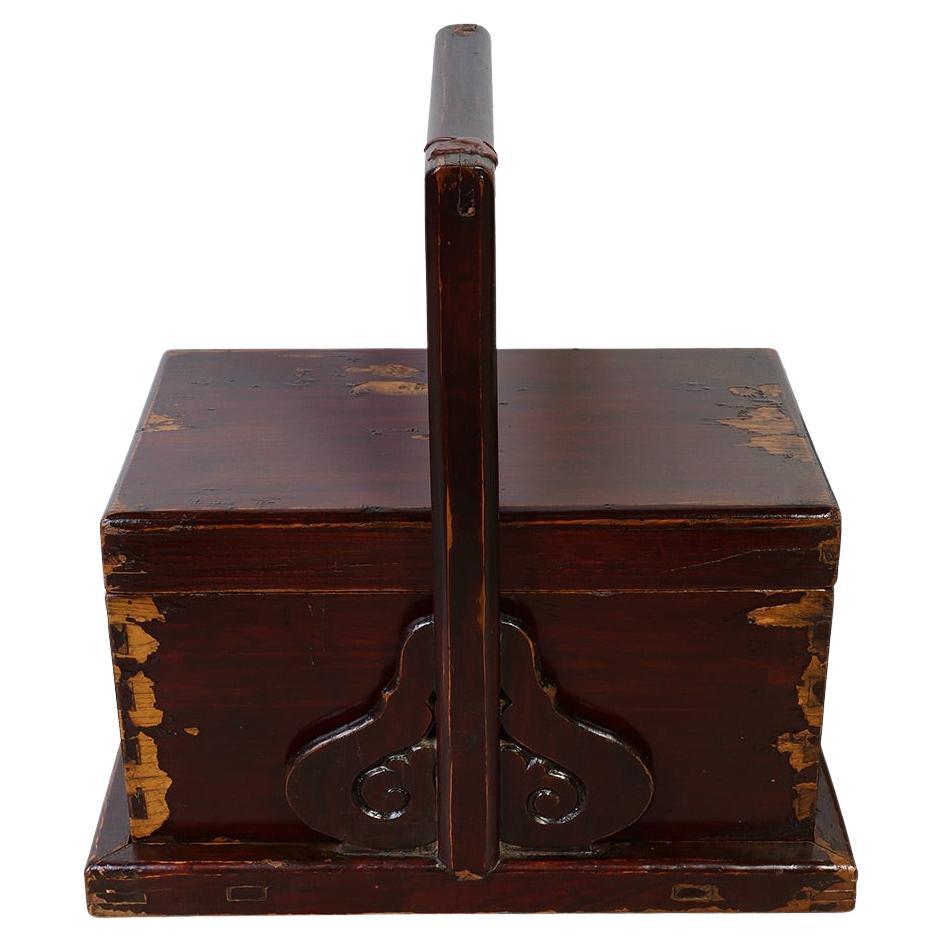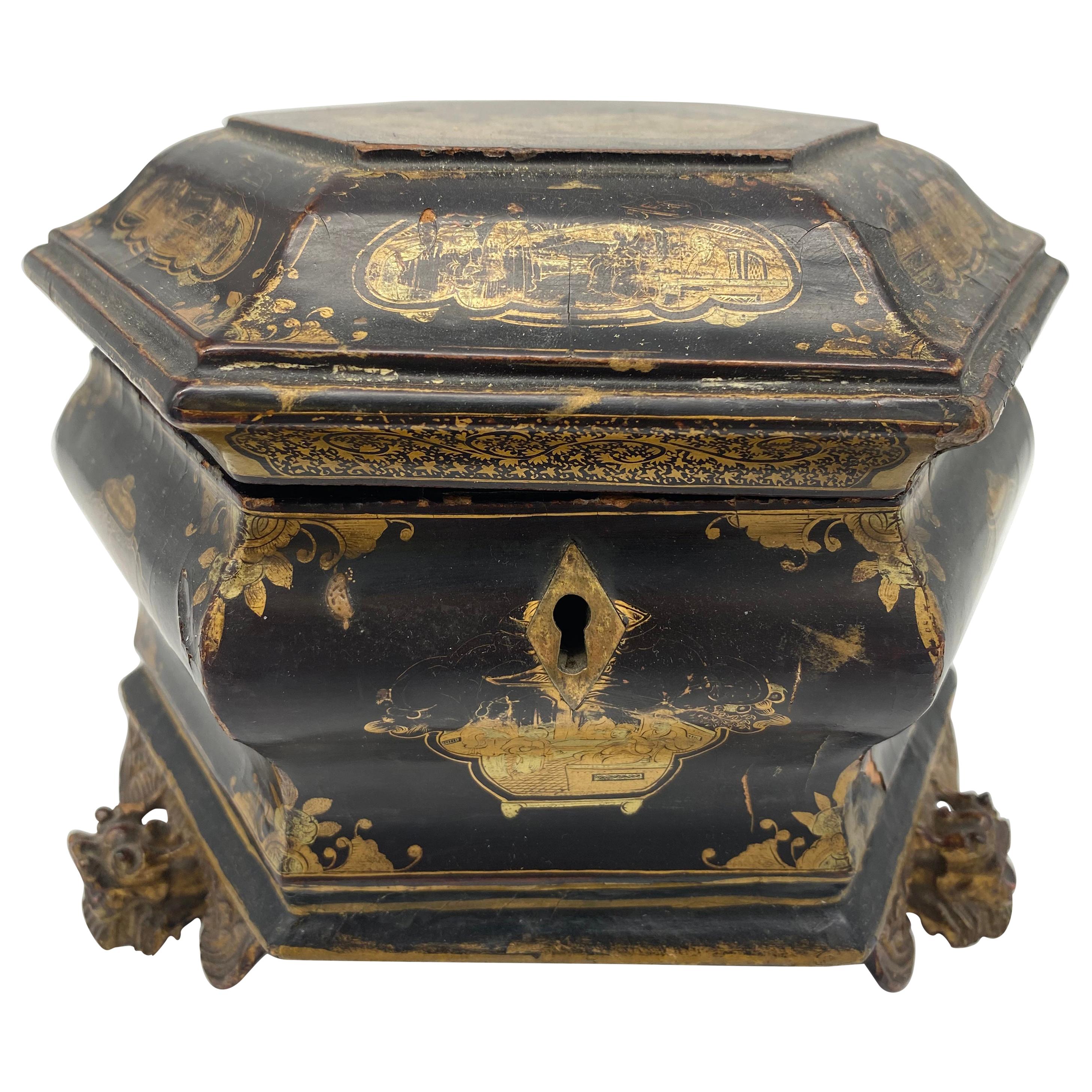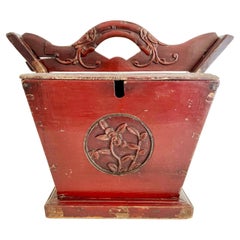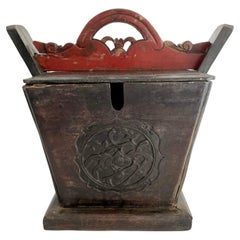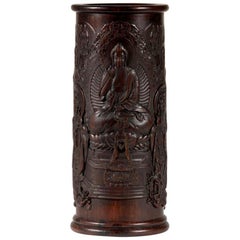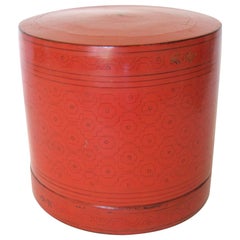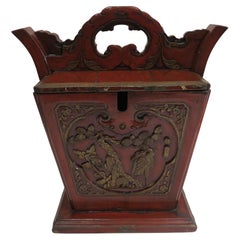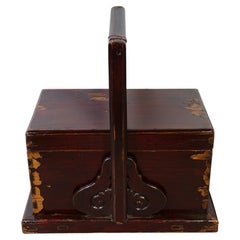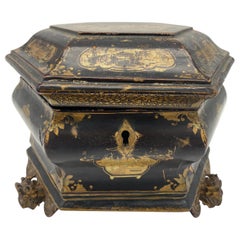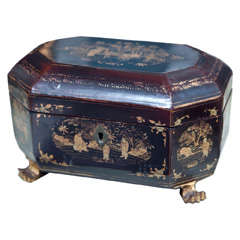Items Similar to Large 19th Century Chinese Carved Tea Caddy
Want more images or videos?
Request additional images or videos from the seller
1 of 12
Large 19th Century Chinese Carved Tea Caddy
$750
£566.91
€651.48
CA$1,044.37
A$1,161.82
CHF 609.04
MX$14,197.15
NOK 7,755.37
SEK 7,300.61
DKK 4,863.03
Shipping
Retrieving quote...The 1stDibs Promise:
Authenticity Guarantee,
Money-Back Guarantee,
24-Hour Cancellation
About the Item
Beautifully carved Qing dynasty tea caddy from Elmwood (yumu), with floral motifs and finished with an oxblood color lacquer. The handle has a finely carved bat motif, which symbolizes good fortune. The large size is very usual and was used in a large family compound. The tea caddy is designed to hold and keep warm, large tea pot filled with tea. The tea pot’s spout comes out the front opening for pouring. The horizontal bar used as the container’s handle has a pivoting lock when open, the handle bar can be removed and closing of the pivoting lock, the handle is secure for use. The wooden tea caddy is then ready to be carried around the home complex and hot tea is kept insulated.
- Dimensions:Height: 16 in (40.64 cm)Width: 18.25 in (46.36 cm)Depth: 13 in (33.02 cm)
- Materials and Techniques:
- Place of Origin:
- Period:
- Date of Manufacture:circa 1880
- Condition:Wear consistent with age and use.
- Seller Location:Atlanta, GA
- Reference Number:Seller: Tea caddy 31stDibs: LU945030569232
About the Seller
4.9
Platinum Seller
Premium sellers with a 4.7+ rating and 24-hour response times
Established in 2006
1stDibs seller since 2010
564 sales on 1stDibs
Typical response time: <1 hour
- ShippingRetrieving quote...Shipping from: Miami, FL
- Return Policy
Authenticity Guarantee
In the unlikely event there’s an issue with an item’s authenticity, contact us within 1 year for a full refund. DetailsMoney-Back Guarantee
If your item is not as described, is damaged in transit, or does not arrive, contact us within 7 days for a full refund. Details24-Hour Cancellation
You have a 24-hour grace period in which to reconsider your purchase, with no questions asked.Vetted Professional Sellers
Our world-class sellers must adhere to strict standards for service and quality, maintaining the integrity of our listings.Price-Match Guarantee
If you find that a seller listed the same item for a lower price elsewhere, we’ll match it.Trusted Global Delivery
Our best-in-class carrier network provides specialized shipping options worldwide, including custom delivery.More From This Seller
View AllLarge 19th century Chinese Carved Wooden Tea Caddy
Located in Atlanta, GA
Beautifully carved Qing dynasty tea caddy from Elmwood (yumu), with floral motifs and finished with an oxblood color lacquer. The large size is very usual and was used in a large family compound. The tea caddy is designed to hold and keep warm, large tea pot filled with tea. The tea pot’s spout comes out the front opening for pouring. The horizontal bar used as the container’s handle has a pivoting lock when open, the handle bar can be removed and closing of the pivoting lock, the handle is secure for use. The wooden tea caddy...
Category
Antique Late 19th Century Chinese Sculptures and Carvings
Materials
Elm
Large 19th Century Chinese Carved Tea Caddy
Located in Atlanta, GA
Beautifully carved Qing dynasty tea caddy from Elmwood (yumu), with floral motifs. Beautiful original patina, the body is in a brown lacquer and the handle is finished with an red color lacquer. The large size is very usual and was used in a large family compound. The tea caddy is designed to hold and keep warm, large tea pot filled with tea. The tea pot’s spout comes out the front opening for pouring. The horizontal bar used as the container’s handle has a pivoting lock when open, the handle bar can be removed and closing of the pivoting lock, the handle is secure for use. The wooden tea caddy...
Category
Antique Late 19th Century Chinese Sculptures and Carvings
Materials
Elm
Finely Carved Chinese Brush Holder Pot
Located in Atlanta, GA
Chinese Rosewood brush holder (pen pot) circa late Qing dynasty. Finely carved on surface with a sitting Buddha on lotus throne holding his hands in Vitarka mu...
Category
Antique 19th Century Chinese Chinese Export Scholar's Objects
Materials
Wood
Early 20th Century, Large Burmese Betel Box, “Kun It”
Located in Atlanta, GA
Burmese (Myanmar) Lacquerware has a long tradition dating back to the 13th Century. Lacquer in Burma is called “Thitsi” meaning the sap of a Thitsi Tree (Melanhorrea Usitata). Typica...
Category
Early 20th Century Burmese Lacquer
Materials
Bamboo, Lacquer
Rare Antique Korean Bandaji Chest South Jolla Joseon Dynasty
Located in Atlanta, GA
A Korean Bandaji Chest circa 19th century (toward the end of Joseon Dynasty) from South Jolla (Cholla) province. Bandaji is known as drop-front half opening chest and was traditional...
Category
Antique 19th Century Korean Other Furniture
Materials
Iron
Rare Extra-Large 19th Century Chinese Painted Leather Trunk
Located in Atlanta, GA
This extremely large Qing Dynasty leather trunk is beautifully painted with a tradition Chinese landscape scene over the oxblood color painted leather. The interior top is painted as...
Category
Antique Mid-19th Century Chinese Furniture
Materials
Leather, Lacquer
You May Also Like
Antique Chinese Tea Pot Caddy
Located in New York, NY
Antique Chinese Tea Caddy. Late 19th century early 20th century Elm Wood carved gilt red lacquered tea caddy. In very good condition a beauti...
Category
Antique 1890s Chinese Qing Scholar's Objects
Materials
Elm
19th Century Chinese Hand Carved Meal Delivery and Lunch Box
Located in Pomona, CA
This Antique lacquered lunch box from Shan Xi, China has over 140 years history and still maintained very good condition. There are some traditional carving works on the two sides handle and shows the traditional style of Northern China's cultural. This antique lunch box...
Category
Antique Late 19th Century Chinese Chinese Export Jewelry Boxes
Materials
Wood
19th Century Chinese Lacquer Tea Caddy
Located in Brea, CA
19th century Qing Dynasty Chinese export gilt decorated black lacquer tea caddy. Hexagonal shape with floral chased pewter covered caddies deta...
Category
Antique 19th Century Chinese Qing Lacquer
Materials
Lacquer
19th Century Chinese Export Lacquer Tea Caddy
Located in Mt Kisco, NY
The burgundy / brown lacquer is decorated with gold depicting figures and buildings in a landscape. The caddy stands on four carved wooden feet in the shape of claws. The interior contains a single pewter canister...
Category
Antique 19th Century English Tea Caddies
19th Century Chinese Stacked Snack Box
Located in Brea, CA
Antique 19th century Chinese stacked snack box. Decorated all-over with intricate designs, with a beautiful design of people on top. Height of box with...
Category
Antique 19th Century Chinese Qing More Asian Art, Objects and Furniture
Materials
Bamboo
Late Qing Dynasty Wedding Box with Carved Handle, Animals and Foliage Motifs
Located in Yonkers, NY
A late Qing Dynasty period wedding box from the early 20th century, this piece exudes charm with its traditional design and intricate carvings. The box features an appealing hexagona...
Category
Early 20th Century Chinese Decorative Boxes
Materials
Wood
More Ways To Browse
Front Bar Carved
Tea Warmer
Chinese Lock
Large Chinese Carved Sculpture
Chinese Container
Antique Chinese Lock
Chinese Wooden Carvings
Large Chinese Pots
Antique Tea Warmer
Chinese Tea Pots
Hand Carved Bar Asian
Chinese Oxblood
Large Tea Caddy
Antique Tea Container
Antique Chinese Tea Caddy
Lacquer Tea Caddy
19th Century Chinese Tea Caddy
19th Century Chinese Lacquer Tea Caddy
